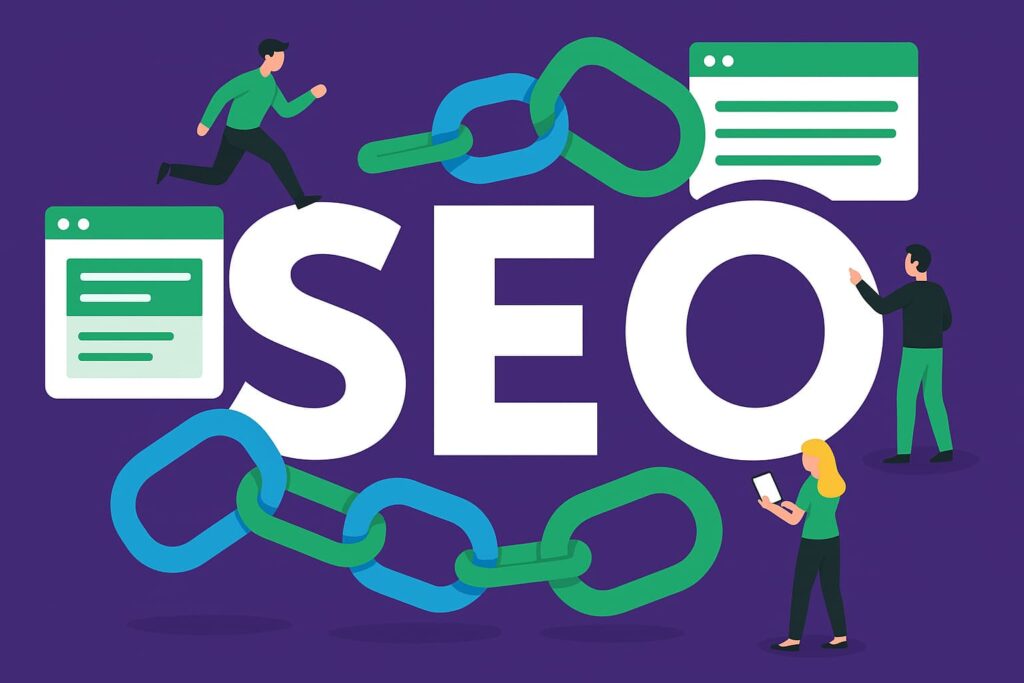SEO multiple links to same page is one of those under-the-radar topics that can confuse even experienced marketers. At first glance, it might seem simple. If multiple links point to the same page, shouldn’t that boost its ranking power? But search engines don’t quite work that way.
In fact, a large 2025 dataset analyzed more than 23 million internal links across 1,800 websites. It found that pages with around 40–44 internal links received about 4× more Google Search clicks than URLs with just 0–4 links. That stat alone shows how much internal link structure can influence organic performance.
Still, when several links point to the same destination, it’s important to understand how Google processes them and whether they help or hurt your SEO.
What Does It Mean to Have Multiple Links to the Same Page?
“Multiple links to the same page” simply refers to instances where more than one hyperlink points to the same URL. This can occur either:
- Within the same page (for example, a homepage linking to a services page from both the header and body copy), or
- Across multiple pages (for example, several blog posts linking back to a main pillar page).
This scenario is common. Navigation menus, sidebars, calls-to-action, and even repeated contextual mentions can naturally lead to multiple links pointing to the same destination.
The key is understanding why those links exist and how they’re interpreted by search engines. Google’s algorithm doesn’t treat all links equally; it evaluates their placement, context, and anchor text to determine their relevance and value.
How Google Handles Multiple Links to the Same Page
Googlebot, the crawler that scans your website, is built to handle redundancy intelligently. Historically, many SEOs believed Google only counted the first anchor text it encountered when multiple links pointed to the same URL.
Today, Google’s systems focus far more on contextual understanding and user intent than strict “first-link priority.” Modern algorithms analyze page structure holistically, factoring in whether links help users navigate or clarify topic relationships.
That means multiple links aren’t necessarily bad – as long as they add clarity and value. If both a navigation link and a body link serve different purposes (one for usability, one for context), Google is sophisticated enough to recognize the difference.
The biggest takeaway: link intent matters more than link count. Multiple links to the same page won’t hurt you if they make sense for users and reinforce topical hierarchy.
When Multiple Links Help SEO
There are plenty of scenarios where having multiple links to the same page is beneficial both for SEO and user experience.
1. Enhancing User Navigation
When visitors can easily find a key page from multiple areas (like the header, sidebar, or footer), it improves accessibility and engagement. These signals can indirectly boost SEO performance, since users spend more time on your site and explore deeper content paths.
2. Strengthening Topical Relevance
Contextual internal links within blog posts or service pages help Google understand content relationships. For example, linking multiple times to your “SEO Services” page – from different blog topics like “Technical SEO” or “Keyword Research” – reinforces its importance within your site’s hierarchy.
3. Supporting Pillar Page Strategies
If you’re using a content cluster strategy, multiple internal links back to the main pillar page help consolidate authority and distribute link equity efficiently.
In the same 23M-link dataset, pages with at least one exact-match internal anchor were associated with 5× more Google Search clicks than pages without.
When Multiple Links Can Hurt SEO
Of course, not all multiple links are helpful. In some cases, they can backfire, especially when implemented carelessly.
1. Over-Optimization or Keyword Stuffing
If every link uses the same exact-match anchor text (like “best digital marketing agency”), it can appear manipulative to Google. This repetition may trigger over-optimization signals and dilute credibility.
2. Poor User Experience
Too many identical links clutter the page and distract readers. When users perceive content as spammy or redundant, bounce rates rise, which indirectly affects your rankings.
3. Footer and Sidebar Link Abuse
Some websites overload their footers or sidebars with repeated links to the same pages, thinking it boosts internal authority. In reality, it can reduce the comparative value of contextual body links, which typically carry more SEO weight.
4. Mixed Anchor Signals
If your multiple links use inconsistent or irrelevant anchor text, Google might struggle to interpret the destination page’s focus. Consistency and clarity are crucial to preserving link equity.
5. Crawl Budget Inefficiency
For large websites, too many redundant links can waste crawl budget.The number of pages Googlebot will crawl in a given timeframe. Simplifying unnecessary internal links ensures important pages get crawled and indexed more efficiently.
Best Practices for Managing Multiple Links
Done right, multiple links can strengthen your internal architecture without confusing search engines. Here’s how to balance user experience with SEO best practices:
1. Prioritize Contextual Links
Links embedded naturally in body content usually carry more ranking power than those in headers or footers. Focus on adding contextual links that genuinely assist readers.
2. Maintain Anchor Text Consistency
While it’s good to vary wording slightly, make sure all anchor texts related to one page reinforce the same theme. For example, “SEO strategy guide” and “learn more about SEO” are consistent but not repetitive.
3. Limit Redundant Linking
Avoid linking to the same page multiple times within a short section of text. One contextual link per major section is usually enough.
4. Audit Your Internal Links Regularly
Use tools like Ahrefs, Screaming Frog, or Google Search Console to identify duplicate or excessive internal links.
- Check for broken links or redirect chains.
- Flag pages with too many outbound links to the same URL.
5. Link to Pages That Deserve It
Multiple links should reinforce priority pages like cornerstone content, key service pages, or lead magnets, not low-value pages or archives.
6. Keep User Experience First
If adding another link makes your content easier to navigate or understand, it’s probably a good decision. If it feels repetitive or forced, remove it.
Example: How to Apply This in Practice
Let’s say you’re writing a blog post about local SEO strategies. You might include:
- A header link to your SEO Services page.
- A contextual link within the text saying, “Learn how our local SEO services help small businesses rank higher.”
- A final call-to-action button at the bottom leading to the same page.
All three links go to the same destination, but each serves a unique purpose: navigation, context, and conversion.
That’s an ideal structure that agencies like Sierra Exclusive apply when optimizing internal linking frameworks for clients across:
Conclusion
Having multiple links to the same page isn’t an SEO red flag. It’s an opportunity to reinforce your site’s structure when used strategically. Google’s crawlers understand that different links can serve different user intents, and as long as your linking practices improve accessibility and context, they can positively impact rankings.
The key is moderation and intent. Be deliberate about where and how you link, keep anchors relevant, and audit your internal links regularly. When balanced with good content and technical SEO, multiple links to the same page can actually enhance your website’s visibility.
Frequently Asked Questions
1. What happens if you link multiple times to the same page internally?
Google crawlers recognize when several links on one page point to the same destination. Typically, only the first link’s anchor text carries SEO weight, but all contribute to navigation and crawl paths.
2. Will multiple links to the same URL dilute PageRank or ranking power?
No, PageRank isn’t split or weakened by multiple internal links to the same URL. Google consolidates signals and evaluates the link’s overall relevance and context instead.
3. Should you use different anchor texts when linking to the same page multiple times?
Slight variations are fine, but all anchors should reflect the same topic intent. Avoid keyword stuffing or using unrelated anchors, as that can send mixed signals to Google.
4. How many links to the same page is “too many” from a user-experience or SEO perspective?
There’s no strict limit, but excessive repetition can look spammy and confuse users. One or two contextual links per page section is usually ideal.
5. Are links in navigation/footers treated differently than contextual links when they point to the same page?
Yes, navigation and footer links mainly serve usability, while contextual links in body content carry stronger SEO weight. Google prioritizes links placed within meaningful content.
6. Does the order or position of links (first link vs subsequent) matter when multiple links point to the same page?
Traditionally, Google only counted the first anchor text it encountered, but modern algorithms focus more on context. Still, make sure your first instance is the most descriptive and relevant.
7. How does this affect crawl budget and site architecture when many links point to the same page?
Too many redundant links can waste crawl budget and clutter your internal structure. Streamlined linking helps Googlebot navigate efficiently and prioritize key URLs.
8. Is it better to link to several pages vs. linking many times to one top page in a content cluster strategy?
Balance is key. Cluster content should link to both pillar and supporting pages. Linking only to one top page may limit the flow of authority through your site’s network.




